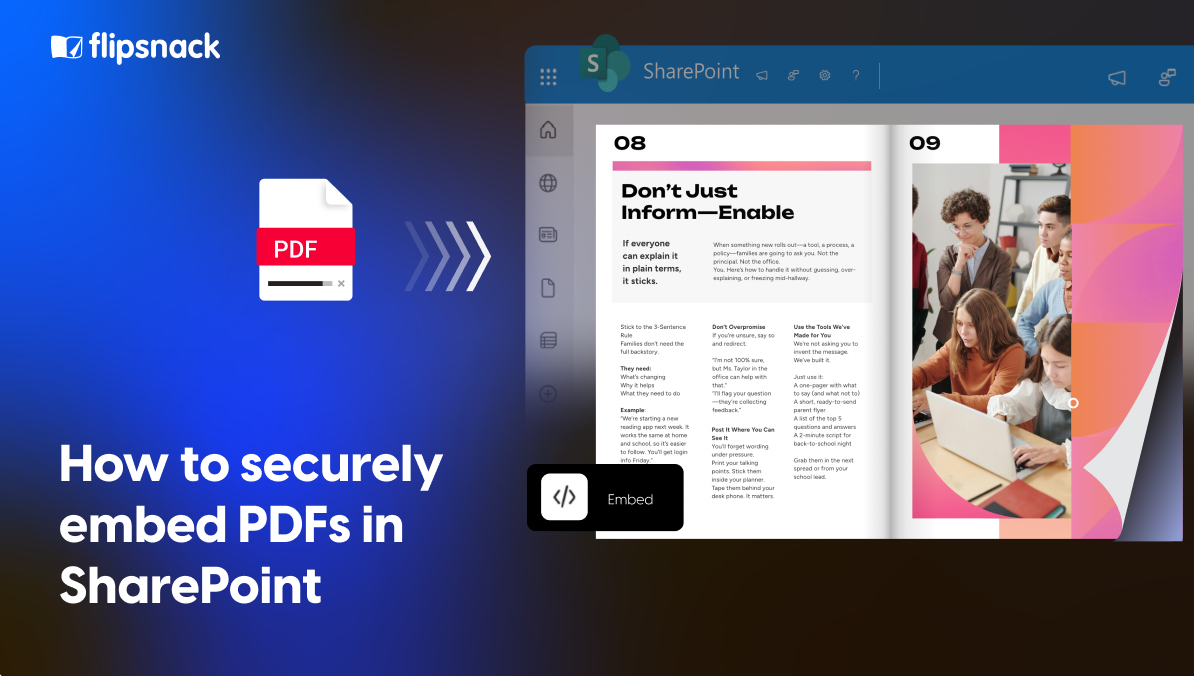Secrets to leveling up internal corporate communication
Internal corporate communication is important for any brand, big or small. And now, with the great resignation happening, it’s more important than it’s ever been to make sure that all employees are on the same page. It’s time to take internal corporate communication to the next level.
Internal communication is also one of the most important tools HR teams have for creating and maintaining employer branding. Recent studies have shown that internal communication and employer branding is blending together.
Internal corporate communication involves everyone that has a stake in the company. Employees, managers, and supervisors. Everyone from the top corner office all the way down to the warehouse janitor’s closet. It involves speaking openly and clearly, being completely transparent with all communication within the company.
That being said, it’s easy to see why you might need a concrete strategy to make sure your internal communication is spot-on. That doesn’t mean that it’s always easy. Some businesses have dedicated positions just for internal communication, and today, we’re going to be talking about some of the secrets that can help you get your own internal corporate communication strategy on track and make it work in your favor.
What to look forward to in this article:
- What exactly is internal corporate communication?
- What are the main Internal Communication Benefits?
- How to Build an Internal Communication Strategy that works in 2022?
- Simple secrets to level up your internal communications
- Conclusions and takeaway
What exactly is internal corporate communication?
Essentially, internal communication is the action or function responsible for effective communication within an organization. As an example, this could be anything from a simple message on a message board, all the way up to an entire corporate presentation. Typically, the people in charge of internal communication are HR representatives or a designated expert in the field.
For someone unfamiliar with the idea, this definition might seem a little broad. But in actuality, everyone is already very familiar with this concept. But, for the sake of clarity, let’s talk about some documents that can be considered internal communication:
- HR documents
- Onboarding documents
- Internal guides
- Employee benefits guides
- Employee handbooks
- Health & wellbeing documents
- Company newsletters
- Reports
- Even messages posted to work group chats
Some companies are conventional with their communication, and some aren’t. Realistically, it is very difficult to find examples of internal communication among companies (after all, it is internal). However, Spotify’s TK Breuer has detailed a lot of their strategy on tackling internal communication in the best way that they know how.
After reading up on them, you can really see the amount of work and detail that goes into what they do. They have 80+ “communicators” collaborating to get their messaging perfect. They spread their communications across multiple channels, but TK noted that he works with other professionals to publish an internal newsletter called “The Note”, three times per week.
Their goal with this newsletter is to break down crucial company news into fun, playful, and easily-digestible conversations. And of course, they make sure to add plenty of music, podcasts, and emojis along the way. Although not every company can do this, it is completely on-brand for Spotify.
What are the main Internal Communication Benefits?
Internal communication isn’t about chatting with your coworkers all day long about anything and everything. Developing a good communication strategy comes with a giant list of benefits. That’s why so many companies have workers dedicated to creating and executing such a strategy. What are the main benefits and KPIs of internal communication?
- It makes everyone feel more valued and included
- It increases contribution from employees
- Keeps everyone more informed about what’s going on in the company
- Improves the ability to set and achieve goals on a personal level and company-wide level
- Faster response time in case of problems and emergencies
How to Build an Internal Communication Strategy that works in 2022?
Building an internal corporate communication strategy is hard to break down on a generic level. The truth of the matter is that each and every company uses what works for them. Sure, there are some pointers that we can give (and we will, later in this article), but all employees will act differently.
Kate Jones, Chair of the Institute of Internal Communication says that there are 3 fundamental properties of good internal communication:
1. Inform
“Communication starts with clear messages, which show what people need to do as a result. We then need to give them the tools and training they need to do that.”
2. Inspire
“This is about making people proud to work for your organization, feel that they are recognized and are valued for what they do. It’s important to celebrate their work and the work of their colleagues through internal comms channels.”
3. Involve
“This is about tapping into the employee’s voice. It’s not enough to just broadcast messages to employees as part of a one-way process. You must listen to what workers say and use that insight to shape business change.”
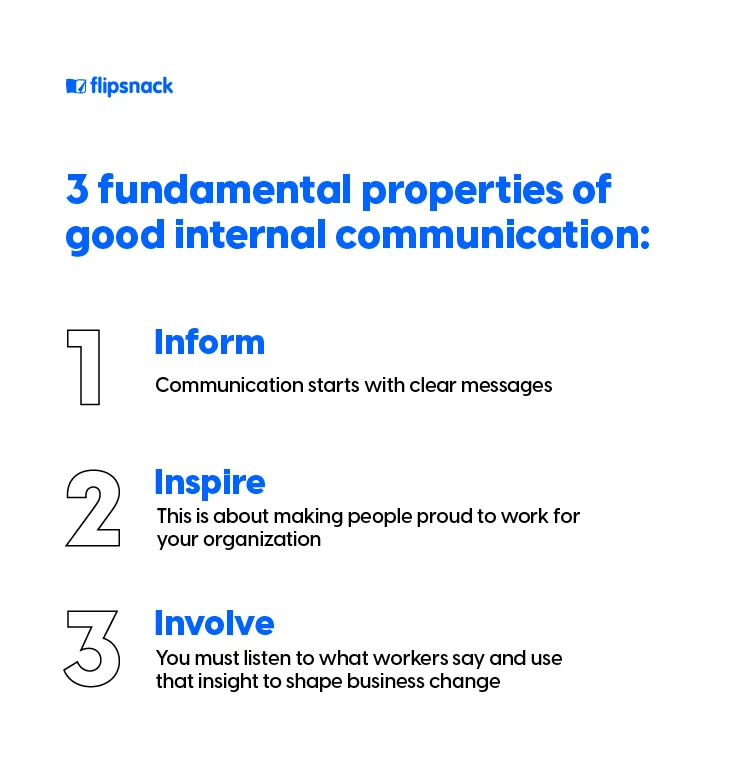
Regardless of how you choose to communicate internally, the expert’s advice is that you follow these 3 basic principles in order to make the biggest impact. If your goals don’t align with what Kate had to say, the odds are that anything you try to communicate won’t sit well or be seen by a majority of the company.
Simple secrets to level up your internal communications
Now that we’re all on the same page about what internal corporate communication is, it’s time to dive into some ways that you can level up your own strategy in the workplace. We’re not going to be talking about generic points like “Have an open door policy”. Stuff like that is a little obvious.
Instead, we’re going to go over maybe some of the more unknown tips, and even some ways that you might actually be harming your internal communication strategy without even knowing it. Let’s start with the “Do’s”.
Make it fun
Yep. If your company culture allows fun communication, make it fun! Internal documents and communication in general doesn’t have to be boring. In fact, I’d say that the more mediocre it is, the less likely employees and colleagues will be to read it. Whether it’s an email, an HR document, or an internal presentation, a giant block of text is pure torture.
What can you do instead? Make it interactive. Add videos and images, break up the text with fun colors and elements, add a fun survey asking what everyone wants to order for lunch that day, or anything else you feel like adding to distract people from the traditional boring-ness of plain black-and-white documents. Atlassian, for example, divides work into in tasks, epics and stories in Jira, its workplace management software.
Interactivity means videos, GIFs, and other fun elements that elevate the document to new heights. Stuff like this gets people engaged, talking about the presentation, and overall enjoying their time. Take a look at this flipbook example below to see how interactive elements change the presentation completely.
Throw out top-down communication
Top-down communication relies on the fact that the person/people at the top are always on the same page as the rest of the company. Although they definitely should be, it’s not always the case.
In this internal communication strategy, the leaders in the company pass out information to everyone below them, and that’s it. Doesn’t sound very productive, does it? That’s because it’s not, yet it’s how so many big companies operate on a daily basis.
This form of communication is not only counter-productive, but it can be dangerous. It puts everyone out of touch with the other party. Managers never receive any information from employees, making them isolated from everything that’s actually going on. Employees sit there and wait for news to be passed around like monthly rations, instead of making the effort to communicate to upper management.
The best advice anyone can give you in your internal corporate communication strategy is to completely throw out the top-down communication and rely on cross-communication. Everyone should feel free to speak freely at all times.
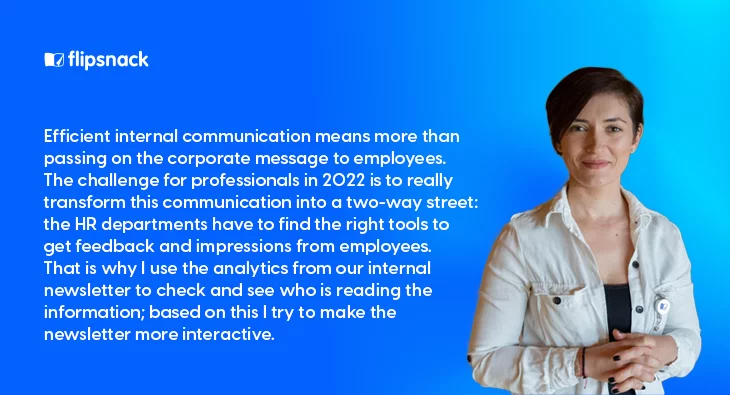
Use emails only when necessary
You know those meetings that could have been an email? Well what about those emails that should have been a meeting? The truth is that there are plenty of announcements that only justify a message in the group, or even a short email, but too many companies rely on email as their main forms of communication.
Afterall, according to Slicktext, up to 60.8% of employees ignore emails while at work. It’s not just that they’re intentionally ignoring you or your organization. It’s that they simply do not have time to sort through the potentially hundreds of emails they receive on any given day. On top of that, Sanebox has discovered that 62% of emails that employees receive aren’t important.
Emails are necessary, but not always the best option. Sure, you can attach documents and links, but I can almost assure you that the engagement rate is low. Why is that? Well, think about your own inbox. As it sits right now, you might have hundreds or even thousands of unread messages in there. The same could be said about other colleagues. Another email will almost certainly get lost within the madness.
This isn’t to say that you should bombard everyone with meetings, but you should think about trying to avoid emails. Instead, find other ways to interact with your colleagues. Set up a meeting with the sales team to let them know about the new pitching procedures, interact with the development team at lunch to discuss the latest in data privacy laws, and consider sharing a meeting recording for those who couldn’t attend in real-time. Communication with all parties involved so that you can communicate any important information.
Emails should be used as a last resort, or for if you’re sharing documents. Even then, a good chat will ensure engagement, and you can email the documents after.
Make communication easy and convenient
Internal corporate communication should be easy and convenient for everyone receiving the message. What does that mean? Well, for a company with a significant amount of employees, it means meeting them where they’re at.
It is estimated that up to 80% of employees don’t work at a conventional desk. This means that they’re remote, at home or in a coffee shop somewhere without a normal office. These employees rely on their laptop and other mobile devices. You have to think of these employees, too. Network Right says proper infrastructure management is essential for maintaining seamless communication across distributed teams.
Think about a normal conversation outside of the working environment. What if you had to go out of your way, across town, in a car that was unfamiliar to you, only to listen to a lecture in a language that you didn’t speak. Sounds a little stressful, right?
The same can be said about your internal corporate communication. If employees are going out of their way to find your messages and understand them, engagement will be minimal. You have to use their apps, techniques, and the lingo that they’re used to.
That being said, a company should take these opportunities to reinforce their culture and values. Sure, you want to bend to the ways of the people, but you also want to highlight what the company is about with every chance you get. There has to be balance.
Utilize social media
Speaking of meeting employees where they’re at with internal communication, let’s highlight social media for a minute. Social media took the world by storm not so long ago, and it has transformed the way everyone operates on a personal and professional level.
Using social media to contact, inform, and reach out to employees for the sake of internal communication is an incredible idea. It brings something that they’re familiar with at the working table, integrating workflows that you know they’re already using.
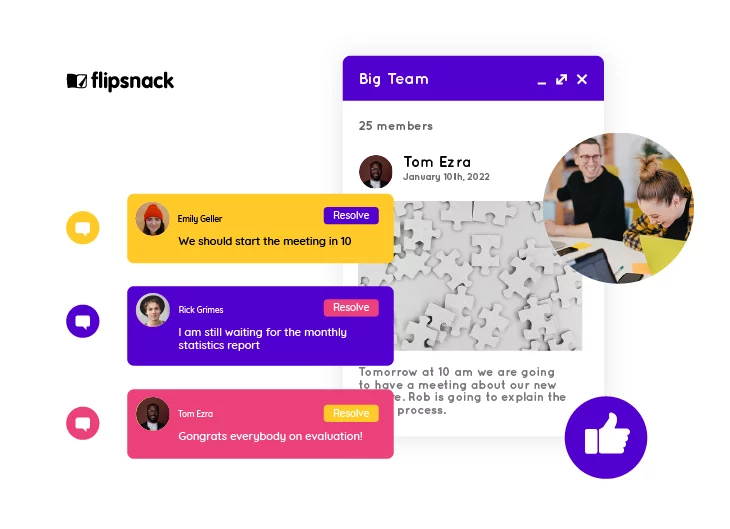
The reason I bring this up separately is because there’s some pretty convincing data that shows that it works. A wonderful woman by the name of Catrin Lewis discussed her strategy in using social media for internal communication, and she confirmed that after only 1 year, she had a 100% engagement rate.
Her secret? She used Hootsuite to manage all of the various social platforms that she used to send out internal communications documents. That’s it! She took on the job not expecting much, with zero budget, all by herself, and turned it into one of the most successful case studies for internal communication that I’ve ever heard.
The don’t’s of internal communication
We’ve gone over some tips on how you can optimize your internal corporate communication strategy, but now it’s time to talk about things you shouldn’t do. The following points are equally as important to the integrity of your strategy.
Don’t think that one message is enough
We kind of hinted at this above, but one message is usually not enough. In the wrong situation, your message can be interpreted incorrectly, and never acted upon. The idea behind following up with your initial message is so that you can provide clarity.
One single document or one internal campaign simply will not work the same for everyone. In an office where you have software engineers and customer service representatives sitting next to each other, this is especially true. You have dozens of people, all from different factions of life, all receiving the same exact message. Make sure everyone understands, even if it means following up after the first message.
Don’t assume everyone will be open to change
Again, because you have different people across different levels of the company, not all changes will be welcomed the same. Although not much can be done about this, it is your job to understand that before the message is sent.
A good example of this would be a new feature being axed because of its low demand. This might come off as a simple change for the marketing team, but it’s probably quite a big deal with the development team that’s spent hours working on it.
Don’t rely on a single channel
This might go without saying considering what we talked about above, but using a single communication channel is like using one oar to paddle a cruise ship. Simply put: it’s inefficient and exhausting.
Social media channels, group chats, emails, message boards, and much more need to be utilized in order to reach everyone. That’s no to say, however, that you should go too far out of your way. What’s important is that you focus on 3-5 of the most important channels first. If Phil from accounting isn’t seeing your messages, it might be time to talk to him.
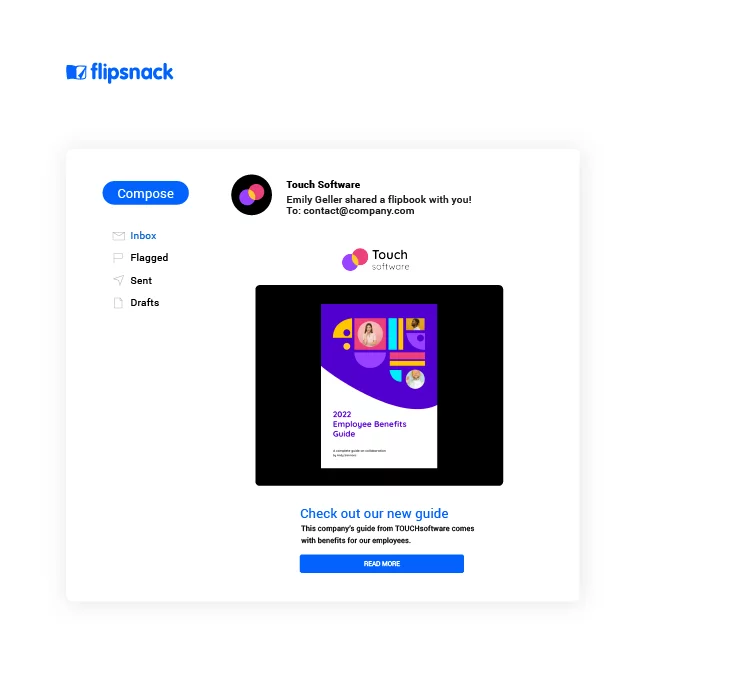
A good example of why this is important is someone that’s not in the office daily. They may not have access to their work email the same way those who are in the office do. Or maybe there’s a conference that multiple colleagues are attending. They don’t have time to check their communication channels, so how will they get the company newsletter? All channels must be used in order to give every equal access.
Don’t try to control everything
As much as we’d all like to control every aspect of our job, it’s not always possible. As an internal corporate communications specialist, your job is to make sure all critical communications are handled. Not every email needs to be monitored, message board needs to be scanned, and presentation needs to be flawless. And tools like Clean Email can help you manage your inbox, allowing you to focus on the most important messages.
The fact of the matter is that you cannot control everything. Trying to do so will drive you and probably the people you work with insane. Give the bulk of your attention to the important campaigns. Everything else should be secondary.
Don’t forget to be fun
Granted, not every company’s culture allows for fun messaging, whether it be internal or external, but you should definitely try to spice it up a little. Bear in mind that there is and always will be a message that needs to be portrayed first. If your idea of fun overrides that, then maybe it’s best to leave it out.
How to create internal communication documents in Flipsnack
Flipsnack provides an easy solution to design, create, and distribute your internal communication documents privately, within your company. The best part is that it’s not complicated whatsoever. It can be broken down into 5 easy steps:
- Log In
Log into Flipsnack and choose to Upload a PDF. You can even create a workspace where you can invite other team members to help create documents.
- Add elements
Add interactive elements such as videos and GIFs, insert links to help guide the readers, and add forms through our embed iframe option to help collect vital feedback.
- Save and publish
Once everything looks perfect, publish the document as unlisted, so that only those that have the link can see it. You can even password protect your documents so that only those with the password can view it. Alternatively, you can create a special workspace specifically for internal documents. You can add everyone in the company via email with the Reader option so that they’re notified every time you publish a corporate document.
- Add readers
If you choose to add readers, you can also check the statistics through Flipsnack. Check to see how many people click your links, how long they spend reading each page, and so on.
- Optional
If you don’t have a designer to help you with PDFs, you can also create your documents within Flipsnack and save it as a branded locked template. This means that you can use the same template in the future, and change the content as needed. All without having to redesign a new document.
It’s as easy as that! The truth is that with your internal documents, you want them to remain internal. Flipsnack provides you with all the tools you need to make that happen, and much more.
Conclusions and takeaway
Internal corporate communication is vital for businesses. Why? Because according to a study done by Gallup, 74% of employees already feel like they’re missing out on important information. This might be because of a multitude of reasons, but that survey says that employees blame the internal communications department, or lack thereof.
Still not convinced that this is a problem? Even if you don’t realize it’s happening, it’s worth looking into and optimizing. Gallup has also discovered that employee disengagement costs the UK £52-£70 billion per year in lost productivity. That’s insane. And to think that it can all be avoided with a decent communication strategy.
Internal corporate communication is all about finding what sticks with the people, and what doesn’t. Some tools give you built-in statistics to help you figure out what’s working and what isn’t. You have to adapt, evolve, and strive to improve with every document you put out there.
All-in-all, internal corporate communication is unavoidable in any striving company. Honestly, in this day and age, we’re given all the tools we need to nail communication campaigns. Internal communication doesn’t have to be hard.


